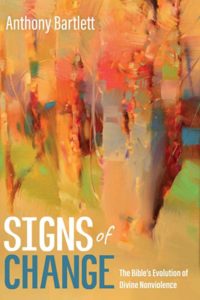
Theology Beyond Metaphysics: Transformative Semiotics of René Girard

Signs of Change: The Bible’s Evolution of Divine Nonviolence
In his recent book The Constitution of Knowledge: A Defense of Truth, journalist Jonathan Rauch makes a compelling case that our shared sense of reality is a product of a worldwide network of those committed to a set of principles and practices he sets out to articulate.1 This network includes scientists, other kinds of academics, medical and legal professionals, journalists, government officials—everyone who participates in the process of open-ended, cumulative inquiry that has led to the spectacular knowledge-building successes of the past few centuries. While Rauch gives a rich description of how participants must relate to each other in order for this network to succeed, he boils the core principles down to two: nothing is ever final, and no one has personal authority; that is, everything is open to question, and anyone’s challenge is welcome and deserving of an answer. This “constitution of knowledge,” on his account, is a modern development, parallel to the political and economic orders of modern liberalism.
Since Rauch aims mainly to answer current threats against truth coming from both the political right and left, he looks no more deeply into how such a constitution could have come about. Deeper answers to such questions, however, are among the many promising implications of the much larger argument of Anthony Bartlett in the two volumes under review. Bartlett, like Rauch, views knowledge as relational. Both, indeed, cite the American philosopher Charles Sanders Peirce as an important exponent of such a view. Bartlett is mainly interested in the transformation of human relationships revealed in and enabled by the Bible, but he brings to bear a semiotic philosophy of language, an anthropology of human violence, and a theology of the Judeo-Christian discovery of non-violence that give his perspective a wide scope indeed.
It would be more common to explain Rauch’s constitution of knowledge through what Charles Taylor calls the subtraction theory of the secular: just get rid of religion and we can all be peaceful and truth-seeking. For Bartlett, however, human relationships are much more broken than this. What is needed is the entrance into history of a new kind of relationship and community, the story that is told in the Bible. Further, the text of the Bible itself initiates new ways of using language that can mediate these relationships of conversion and discovery. This is what Bartlett will call a semiotic way of looking at the Bible, and in order to articulate it he recruits major thinkers such as Peirce, Martin Heidegger, Jacques Derrida, John Deely, Jean-Luc Marion, and especially René Girard.
Bartlett is well known to those interested in Girard and what has come to be called the mimetic theory based on his work. Bartlett’s first book, Cross Purposes: The Violent Grammar of Christian Atonement, is an important early contribution to the theological reception of Girard’s thought.2 In two subsequent non-fiction books and a science fiction novel, he broadened the application of Girard, as captured in the subtitle of Virtually Christian: How Christ Changes Human Meaning and Makes Creation New.3 He writes with a substance, accessibility, and verve that fit his missional sense of the possibilities that the Girardian framework helps unlock within the scriptures themselves. In his two recent, companion volumes, Bartlett lets his horses run, crossing boundaries of philosophy, theology, and biblical studies in order to develop a liberating theological semiotics. Less an attempt at a definitive statement than an invitation to a shared exploration, they are worth a wide hearing.
Though Bartlett does not assume readers will be familiar with mimetic theory, a review of its three main theses is a good way of situating his overall argument.
The first thesis, from which the theory gets its name, is that all human desire is mimetic, meaning unconsciously imitative. This results in a more radically relational view of humanity than already results from previous recognition of the importance of imitation in human language, learning, and art. Such a thoroughly relational anthropology operates in the background of Bartlett’s relational view of knowledge, much like it operates in the background of our sense of ourselves as individuals learning and making choices.
The second thesis, the scapegoat mechanism, receives more direct attention. Mimetic desire leads to rivalries, which tend to escalate into violence that swallows whole communities, and the universal mechanism that evolved for managing this violence is to channel it by blaming and persecuting a single victim, first spontaneously and then in the ritual forms of sacrificial religion. This birth of human culture in violence explains the brokenness that deforms human relationships and, hence, knowledge. But, importantly for Bartlett, the scapegoat mechanism is also seen as critical to the birth of language.
Third, while there are glimmers elsewhere in ancient art, philosophy, and world religions of a critique of mimetic violence, the Judeo-Christian tradition is special in its comprehensive exposure of mimetic rivalry and the scapegoat mechanism and in opening an alternative to it. This is where Bartlett makes his most innovative contribution to mimetic theory by understanding the non-violent alternative not just ethically but as a practice of knowledge and interpretation, one that begins with the Bible and its ways of using language.
Girard’s influence is also reflected in how Bartlett divides his two volumes, one primarily philosophical and the other biblical. While Girard, a Roman Catholic believer, asserted the decisive impact of Judeo-Christian revelation for understanding the truth about humanity and God, he also held that mimetic theory could be pursued scientifically. Thus, Theology Beyond Metaphysics makes a primarily philosophical case for a Girardian semiotics, while Signs of Change traces how the composition of the Bible shows this transformative semiotics at work in history. Within both volumes, Bartlett attends to how the reality he is seeking to articulate can be seen from both a philosophical, secular perspective and a theological, biblical one. The philosophical truth about humanity and language, and the academic disciplines by which we can grow in knowledge of them, are gifts of God’s gracious action at work in history. At the same time, we can better understand this action, as witnessed in the Bible, through academic analysis of the human situation in which the biblical texts were written and first read. What we see from one side as evolution, we can see from the other as apocalypse, in the sense of unveiling or revelation. And this, taking perhaps a step beyond Bartlett, might be just what we should expect of a non-violent, non-coercive God: the power of grace can also look perfectly natural.
Girard’s work began under the influence of structuralist linguistics and shares the post-structuralist, Derridean critique of metaphysics while also pointing beyond it. A key part of the theory of the scapegoat mechanism is that the memory of the murders that temporarily bring an end to runaway violence are erased beneath mythologies of divine deliverance and the evermore sophisticated cultural institutions built on them, including philosophical metaphysics. At the same time, however, the intensity of shared attention that accompanies scapegoating gives rise to the use of signs, from which will grow language. This is a highly conjectural account of the origin of language, one that stands to be integrated with other models of its more gradual emergence. But the power of the Girardian account, as Bartlett develops it, lies in explaining both the depth of the darkness in human culture and the capacity of language to open us to an authentic attention to the other that, under conditions of peace rather than violence, can lead to real growth in knowledge, rather than mere Derridean deferral of meaning, and move beyond the dangerous, premature closures of metaphysics.
Semiotics, like post-structuralism, finds metaphysical systems problematic, but it renders the openness of signs productive, rather than endless, meaningless play, by embedding the relationality of linguistic signs within the relationality of all things, including language users. For the theory of semiotics, Bartlett turns to the underappreciated work of philosopher John Deely, particularly his monumental history of philosophy, Four Ages of Understanding.4 Deely is a major figure in the development of a semiotic philosophy based on the understanding of signs formulated by Peirce. He is responsible in particular for showing how Peircian semiotics picks up on the theory of signs initiated by Augustine and woven into the work of Aquinas (as teased out by the almost entirely overlooked late-scholastic author John Poinsot). Semiotics involves major shifts in familiar categories from post-Cartesian philosophy that are deeply woven into academic disciplines, and Bartlett works hard to invite readers into these shifts. I will try to summarize merely the central ideas that make semiotics a way past the dead end of modern thought pointed out by post-structuralist thinkers such as Derrida.
Signs involve relations that are, as Peirce puts it (and as I first encountered it in the novelist Walker Percy’s brilliant Lost in the Cosmos: The Last Self-Help Book), irreducibly triadic: not just a signifier and its referent, but also what he often calls an interpretant. In the case of conventional signs, like words in a language, the interpretant is the reader or listener. What sets Peircian semiotics apart from structuralism, however, is seeing triadic sign-relations within the natural world itself, what Augustine calls natural signs. Meaning, then, is not a human construct imposed arbitrarily on brute reality of merely dyadic cause-and-effect relations, but is built in, endlessly, to creation. Language mediates our knowledge of these real relations, so that the endless play of language, or infinite semiosis in Peircian terms, can point forward to a real, eschatological growth in understanding.
Combining Peircian semiotics with Girard’s mimetic theory links the general question of sign relations to what is for semiotics the special case of human relations. The foundation of all human systems in violence, both social systems and systems of thought and belief, impedes real understanding. Here Bartlett turns to Heidegger for help in showing the exhaustion of metaphysics (though his Heideggerian critique of the metaphysics of being in Aquinas might be answered by the metaphysics of participation found in Aquinas by theologians such as John Milbank and David Bentley Hart). What is needed in order for an open-ended process of interpretation to approach truth is a certain kind of community. Rauch and Bartlett would agree that such a community must escape the distorting effects of violence (i.e. sin, though Bartlett avoids the term). But for Bartlett, mimetic theory shows the importance of the Bible’s exposure of culture-shaping, truth-distorting violence and tells the story of the formation of a new kind of community around the revelation of a God entirely beyond violence—the story told in Signs of Change.
As a first taste of this exposition, however, Theology Beyond Metaphysics concludes with a chapter on the Gospel of John, which Bartlett sees as “a masterpiece of biblical semiosis” and, thus, the best place to find what it is about the language of Bible itself, not just the community that embraces it, that is transformative (149). Here Bartlett experiments with various ways of analyzing its distinctive semiosis through familiar literary terms such as ambiguity and irony. Marion’s contrast between the idol and the icon from God Without Being is helpful for evoking the way biblical semiosis invites relationship. Bartlett settles finally, however, on the term “slippage,” which for me smacks unhelpfully of Derridean post-structuralism (162). For Derrida, stable meaning requires a transcendental signified, which modern critiques have shown to be either absent or hopelessly implicated in violence. Bartlett’s “slippage” finds openings in language for real relations of peace between persons, both human and Trinitarian, and thus for transcendence to break through.
More helpful might be the hermeneutics of Paul Ricoeur (mentioned by Bartlett in a footnote), such as his term “enigma-expression.” Indeed, I would suggest a connection with what I have called the medieval “poetics of enigma” based on the reception of 1 Corinthians 13:12, where Paul was understood to use the word “enigma” (borrowed by Latin from Greek) for the kind of language that brings us, in this life, closest to what we will know “face to face” in the next.5 Enigmatic language has a density of meaning that resists closure, points to an infinite presence, and invites non-violent interpretation as a focus of peaceful community. The enigmatic, according to medieval literary theory, is found eminently in the Bible because there, not only do the words signify, but so do the things signified by the words. This is the mode of signification often termed figural (as discussed influentially by the literary scholar Erich Auerbach) and called the “allegory of the theologians” by Dante. In the context of Bartlett’s discussion of a Peircian, Girardian, biblical semiotics, this medieval understanding of enigma could be seen to find in the Bible an especially instructive case of how signs are most true when they participate in real relations between things.
Signs of Change, then, builds on the Girardian approach to the Bible begun by Raymund Schwager, SJ, and continued by Girard himself as well as many others, notably James Williams, Walter Wink, and James Alison. Bartlett engages less with these precursors, however, than with a broad range of more influential biblical scholars such as Richard Elliott Friedman, Walter Brueggeman, E. P. Sanders, N. T. Wright, and Douglas A. Campbell. I mention all these names since they will be better known to many readers than they are to me. Hence, I will discuss this volume more briefly.
Bartlett does more than previous Girardian exegetes to situate “the Bible’s evolution of non-violence” within scholarly reconstruction of how the Bible was written in order to consider how the message of a non-violent God and all of its implications could have broken through an ancient mindset steeped in violence to open a new “semiotic space” (xxxi). He begins with Exodus as the primal story of liberation and continues with chapters on Genesis, Job, the Servant of Second Isaiah, Ruth, Daniel, and Jonah as stages in this evolution that track roughly with stages of composition. He concludes with chapters on the Gospels and Paul.
Bartlett’s emphasis throughout is on the semiotic transformation accomplished by biblical texts, that is, how they take language and literary forms that mediated a violent culture dominated by, for instance, the politics of empire and mythologies of violent gods, and remade them in order to signify the non-violent God of Abraham and shape a new kind of community. By looking at the human side of the writing of the Bible—what conditions the texts were likely written in, what it might have been like to write and read them—Bartlett in no way diminishes the meaning of the text. Rather, he augments it by more fully imagining the work of the Holy Spirit in history. In the case of the Hebrew scriptures, this story of a gradual in-breaking of a non-violent revelation helps make sense of the violence that still shadows these texts. Bartlett’s contextual reading of Daniel, for instance, renders it newly coherent as well as non-violent.
Terms related to semiotics crop up frequently in Signs of Change as a shorthand for the reoriented approach to theology developed in Theology Beyond Metaphysics and briefly sketched at the beginning of the latter volume. The usage is itself rather slippery, embracing both the philosophical approach to signs taken from Deely and the potential to transform real relationships found in the Bible’s ways of using language. It might be helpful to plot these uses on the spectrum of language described by C. S. Lewis, in “The Language of Religion,” from rich, multivocal language of poetry and religion on one end to the precise, univocal language of science on the other, with ordinary language in the middle, but tending toward the poetic.6 The work of Girard, Deely, and others has brought scientific language to the point of being able to articulate, and thus better understand, what is going on in the transformative effect of the infinitely rich language of the Bible. Semiotics in the philosophical sense enables us to understand biblical semiotics but also, Bartlett suggests, would not be possible without it.
Indeed, Bartlett’s argument would seem to imply that the history of language itself bears witness to the coming of the Logos, as Lewis’s friend Owen Barfield argues, more narrowly, in “Philology and the Incarnation.”7 In this respect, Bartlett extends Girard’s argument that modern secularism is an outgrowth of the biblical exposure of the scapegoat mechanism that has forgotten its origin. One of Girard’s most pregnant assertions is that the rise of modern science depends on the exposure of scapegoating: it was not possible, for instance, to explain hailstorms meteorologically until we stopped blaming them on witches. Bartlett provides the context for seeing that it is the advent of non-violent community around biblical semiotics that made possible the inclusive communities of knowledge in which could be born, not just the philosophy of semiotics, but everything that goes with Rauch’s “constitution.”
The origins of language lie in the poetic and religious, with scientific language as a hard-won product of what has come to fullest fruition in a community of knowledge that participates in an impersonal process of advancing ideas as precisely and accessibly as possible and attempting to disprove the ideas so advanced. This, I would say, is at once the most minimal and the most inclusive of the eschatological communities of peace made possible by biblical semiosis. Just as hard won, and just as much a work of divine grace, are non-violent communities of faith formed around the infinitely rich as well as infinitely open kind of semiosis that is Bartlett’s focus. It is the vocation of Christian scholars to participate in both kinds of community.
Cite this article
Footnotes
- Jonathan Rauch, The Constitution of Knowledge: A Defense of Truth (Washington, DC: Brookings Institution Press, 2021).
- Anthony Bartlett, Cross Purposes: The Violent Grammar of Christian Atonement (Harrisburg, PA: Trinity Press International, 2001).
- Anthony Bartlett, Virtually Christian: How Christ Changes Human Meaning and Makes Creation New (Winchester, UK: O-Books, 2011).
- John Deely, Four Ages of Understanding (Toronto: University of Toronto Press, 2001).
- See Curtis Gruenler, Piers Plowman and the Poetics of Enigma: Riddles, Rhetoric, and Theology (South Bend, IN: University of Notre Dame Press, 2017).
- C. S. Lewis, “The Language of Religion” in Christian Reflections, ed. Walter Hooper (Grand Rapids, MI: Eerdmans, 1967), 159–174.
- Owen Barfield, “Philology and the Incarnation,” in The Rediscovery of Meaning, and Other Essays (Middletown, CT: Wesleyan University Press, 1977), 228–236.























